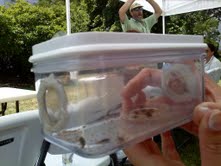The Buzz at the Top of USDA’s Whitten Building
by Wayne Bogovich, The Peoples Garden Apiary Beekeeper
Folks in the area are welcoming USDA’s newest residents, bees! The People’s Garden at USDA headquarters added a beehive in The People’s Garden Apiary which is located on the roof of USDA’s Whitten Building along the National Mall in Washington, DC.
USDA’s newest residents, six pounds (approximately 20,000) of bees and a queen were placed in their new home on April 21, 2010. These bees are facilitating pollination of The People’s Garden as well as the surrounding areas. If you’ve been to the National Mall, you probably recall that there are a lot of gardens at the various Smithsonian museums. And if you haven’t been to the National Mall, you should plan a visit.
The hive’s location was chosen so the eastern exposure of sunlight would get the bees moving in the morning. Directly to the west of the hive is a utility room which provides protection from the prevailing winds and bad weather along with afternoon shade to avoid the late day heat.
We check the hive every 10 days and our volunteers supply fresh water every other day. We do this in addition to checking for fresh eggs as well as any visual parasite or disease issue in order to ensure the health of the colony. We also monitor honey production and we add honey supers as needed. And to facilitate the non-chemical control of mites, we use a ventilated bottom board and remove the drone brood.
Because each of us depends on pollinators in a practical way to provide us with the wide range of foods we eat, we are doing our best in making sure our newest residents have what they need!

Wayne Bogovich, The Peoples Garden Apiary Beekeeper


